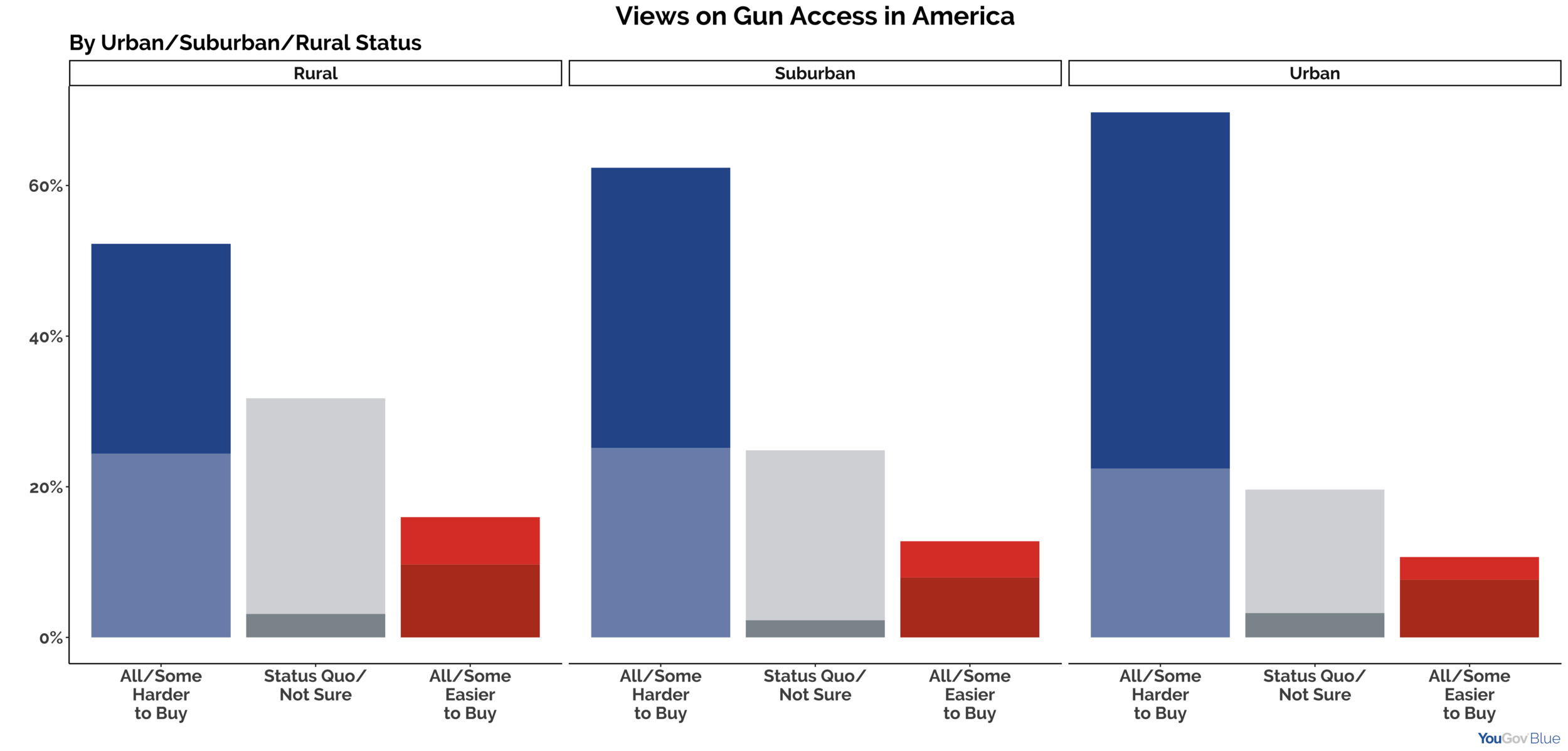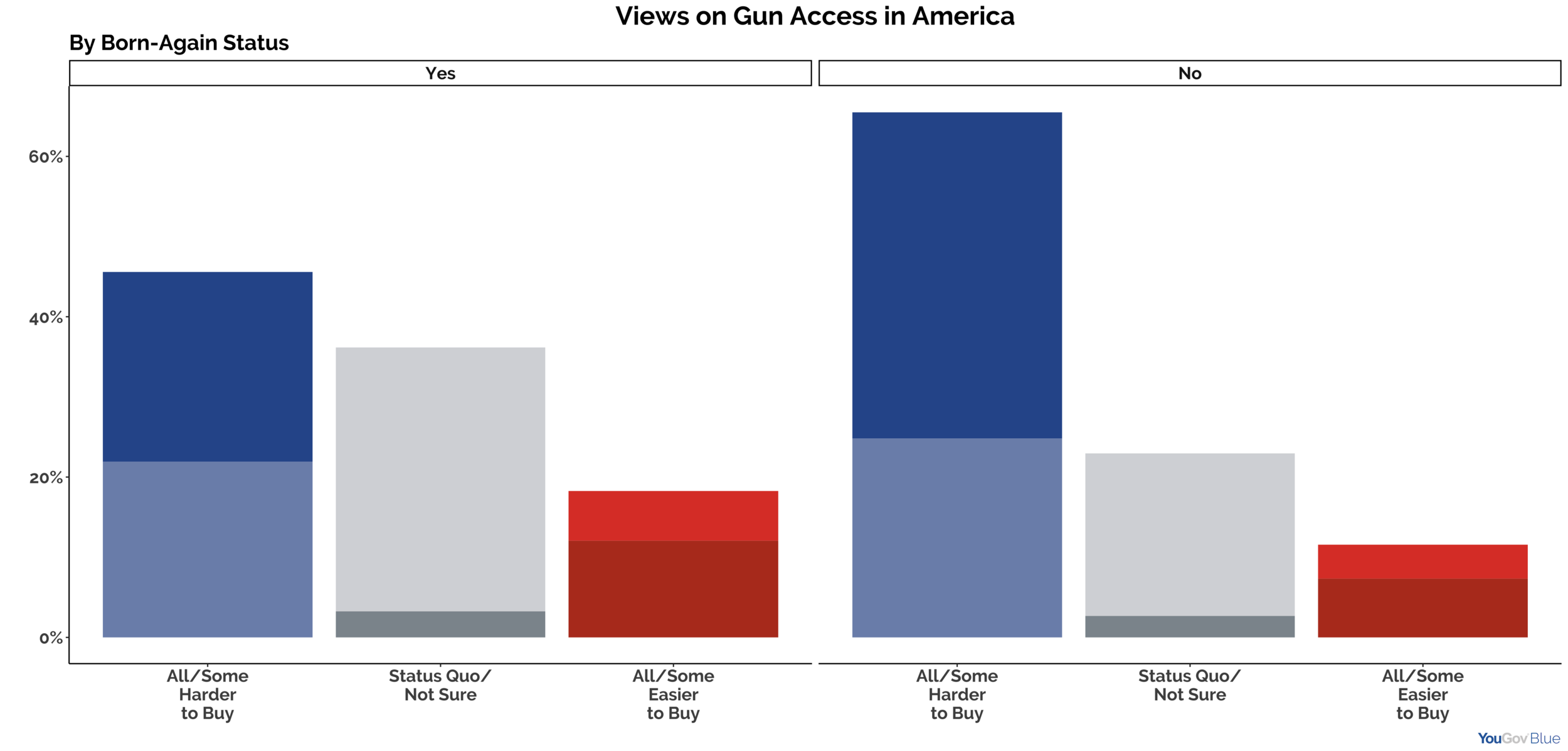Voters Have Spoken — It’s Time to Pass More Gun Regulations
In The Era of Trump, Voters Don't Separate Views on Guns from Views on Race and Gender
By Alissa Stollwerk (@AlissaStollwerk) and John Ray (@johnlray)
The 2018 midterms were notable for the important role that ending gun violence played in the national debate. In the wake of what feels like constant mass shootings -- including in a Pittsburgh synagogue just days before the election -- Democrats have embraced the need for stronger regulations on guns more than they have in decades. In addition to mass shootings, gun violence continues to take a toll in other incidents involving women and people of color.
Over 1,000 candidates campaigned on preventing gun violence in 2018 and won their elections, including 16 volunteer leaders of the movement, according to Moms Demand Action for Gun Sense in America founder Shannon Watts. The most high profile of these candidates is perhaps Lucy McBath, whose son was shot and killed because “his music was too loud,” flipping GA-06, a historically Republican district. In the Senate, the Democrats’ two biggest flips came in Arizona and Nevada, where Democrats ran against Republican candidates with strong NRA ratings and support. Nationally, gun safety groups like Moms Demand and Everytown outspent the NRA for the first time.
As we ask what happened in the 2018 elections, we wanted to understand what role the issue of gun violence played in the electorate. As part of our What the Hell Happened survey, we asked respondents whether it should be more or less difficult to buy guns in this country. The full question read:
Which of the following is closest to your view on gun regulations?
<1> It should be more difficult to buy all types of guns
<2> It should be more difficult to buy some types of guns
<3> The current regulations regarding the purchase of guns are about right
<4> It should be less difficult to buy some types of guns
<5> It should be less difficult to buy all types of guns
<6> Not sure
Note that, unlike some work on the question of gun regulations, we included a response that permitted respondents to say they felt the status quo was about right. We furthermore did not prime respondents with any information about specific gun regulations, such as background checks. Without specific priming and with non-specific wording, we expect our results to be slightly more conservative than some other work on the subject.
Overwhelmingly, Americans are against the NRA’s and the Republican Party’s position that gun regulations should be loosened -- only 14 percent of our sample, representative of the national population of voters, said they agreed with this. Rather, 60 percent of Americans believe it should be harder to buy guns and 26 percent endorsed the status quo or said they were not sure. We also see an important gap in intensity, as 36 percent believe it should be harder to buy all guns but only 9 percent say it should be easier to buy all guns.
What does support for increased gun regulations look like among key demographic groups? We begin by looking at the gender divide, and particularly looking at suburban women. In the wake of gun violence, mothers in particular have increasingly turned their grief into action.
Our data suggest a clear gender divide in attitudes on guns. Sixty-eight percent of women versus 51 percent of men supported making some or all guns harder to buy, and only 8 percent of women think guns should be easier to buy. While a majority of both genders support stronger regulations, this 17 point gap is a stark difference across the sexes.
Likewise, majorities of respondents across rural/suburban/urban status in our survey agreed that some or all guns should be harder to buy. Fifty-two percent of rural, 62 percent of suburban, and 70 percent of urban-area respondents felt this way -- this 18 point gap between rural and urban voters is roughly the same size as the gender gap. But contrary to what some may think, a majority of rural-area voters agree that guns are too easy to buy in America.
So what do we see when we look at support for gun regulations by gender and urbanicity at the same time? Within gender, we find an urban/suburban/rural divide on gun views. While clear pluralities or outright majorities of men and women across urban/suburban/rural status support more strict gun laws, the level of support across gender increases from rural, to suburban, to urban status. The divide among men was stark: from rural to suburban to urban, 42 percent, 54 percent, and 64 percent of men supported stricter gun laws, a 22-point margin from rural to urban. The same gap is present with women, but raw support for increased regulation is much higher -- 61 percent of rural women, 71 percent of suburban women, and 78 percent of urban women support more gun regulation, for a 17-point gap. With 71 percent of suburban women in favor of increased gun control, it is no wonder that Democrats, running on this issue, swept a record number of seats in suburban swaths of the country.
Turning to age, much has been made of the Parkland generation. Would young people, subject to shootings in their schools, clubs, and movie theaters, turn out to vote? The oldest millennials were in high school when the Columbine massacre shook the country, and they were the first generation to start voting that had experienced the fear of school shootings. In the wake of several shootings on college campuses and the activism among young people in the wake of Parkland with March for Our Lives, many commentators wondered if this would translate to added support for gun control candidates at the ballot box.
Indeed, our data shows that young people are more likely to be supportive of increased regulations, though we don’t see as large of a gap as we see across gender or urbanicity. Among millenials and post-millenials, 66 percent respondents say guns should be harder to buy, while all other age groups hover just under 60 percent. Millenials are also more intense in this belief, with a greater percentage of them saying all guns should be harder to buy.
Unsurprisingly, we also found clear divides in gun attitudes by race. Seventy-eight percent of Black respondents and 67 percent of Latino respondents supported making some or all guns harder to buy, compared with 57 percent of white respondents. Just 6 percent of Black respondents accepted the status quo on gun policy, compared to 20 percent of Latinos, 25 percent of other race respondents, and 26 percent of white respondents. Communities of color have been disproportionately affected by gun violence, and the fact that there is not even more of a racial gap goes to show how much consensus has been built on this issue in recent years. Across racial groups, support for tightening gun laws overwhelms support for both more lax gun laws and for the status quo.
Majorities across the major education breakdown (college vs. non-college) also support making some or all guns harder to buy. Fully 55 percent of those without a college degree and 67 percent of those with a college degree support making some or all guns harder to buy. Across both groups, the status quo was preferable to more lax gun laws.
As further proof that born-again evangelical Christianity has become more of a cultural than a religious identity, respondents who self-identified as Born-Again are one of the few demographic groups in our survey who do not cross the threshold of 50 percent support for increased gun regulations. However, even among this group, there was not widespread support for a further loosening of gun regulations, and a plurality of this group does support increased gun regulations.
To turn to partisan markers, among respondents who reported voting for a Republican House candidate in 2018, 45 percent supporting the status quo on gun laws in the United States, versus just 5 percent of those who reported voting for a Democratic House candidate. Republican voters were narrowly split on preferring more strict (27 percent) or more lax (25 percent) gun laws, while Democrats clearly favored more strict (89 percent) over more lax (5 percent) gun laws.
The 2-party vote breakdown is interesting, but it doesn’t tell us about what swing voters think on gun regulations. When we instead look at party identification, we see that this pattern across the parties holds, but -- important for understanding 2018 results -- a large majority of independents (58 percent) support stronger gun laws, while only 15 percent favor more lax gun laws. Expanding access to guns is a losing issue among independents, and this issue provides another reason to explain why key swing voter groups moved to Democrats this cycle.
Even more so than the party ID divide, the ideological divide in our sample shows clear variation in support for new gun regulations in the United States. Unlike those who reported a Republican party ID, or voting for a Republican candidate in 2018, respondents who identified as “very conservative” outright preferred more lax gun laws over more strict gun laws, by a 25 percent to 19 percent margin. Those who identified as “conservative” and “very conservative” also preferred the status quo to both more lax and more strict gun regulations. 45 percent of conservatives and and 46 percent of very conservative respondents preferred the status quo.
In contrast, just 4 percent of liberals and 2 percent of very liberal respondents preferred the status quo, compared to 91 percent and 95 percent who preferred some or all guns be made harder to buy. Self-identified moderates also clearly preferred some or all guns be made harder to buy, with 68 percent holding this view compared to 18 percent of moderates who support the status quo and 10 percent of moderates who support more lax gun laws. As the chart makes clear, these swing-voter moderates look much more like liberals on this issue than they look like conservatives -- and that matters in close elections.
The above evidence shows that large majorities of Americans support increasing gun regulations in our country. This remains true across major demographic divides, including age, gender, race, education, and urbanicity. Even among the most conservative and Republican groups, loosening gun regulations fails to appeal to more than a small percentage of voters.
Modeling Results: Who Holds Pro-Gun Attitudes? Do Pro-Gun Attitudes Influence Vote Choice?
Next, we turn to some results in which we model gun attitudes and partisan vote choice. By using regression models to see how several factors predict opinion, rather than looking at each demographic variable separately, we can attempt to understand which variables are most predictive of opinions on gun regulations.
First, we look at our gun attitudes item as the dependent variable, where higher values represent more pro-gun attitudes. To predict gun attitudes, we included respondents’ age, sex, education, race, party ID, ideology, household income, urban/suburban/rural status, Born-again status, and church attendance.
The chart below shows the coefficients of each of these variables in the regression. All coefficients are scaled to make them comparable. For example, because the scaled coefficient on our race dummy is .02 and the coefficient on Church attendance is 0.1, we can say that the magnitude of the effect of Church attendance on pro-gun attitudes is five times larger than the effect of being white, in this particular model.
This model suggests that conservative ideology, Republican partisanship, and being male are doing most of the work in predicting those Americans who do support further loosening gun regulations. Age, race, religion, and income have little or no statistically significant effect, while a college education, attending church, and living in a rural area all have smaller but significant effects.
In a second model, we added two measures of latent opinion that were included in our survey -- racial animus and hostile sexism. Other work Data for Progress has done on these indices show that respondents’ prejudices are increasingly predictive of Republican vote choice. And we know that gun violence is tied to misogyny and racism in America today. Given this, we wondered, is animus against women and people of color predictive of opinions on guns? Or would those scales play a smaller role compared to party identification and ideology?
The results of the regression including racial animus and and hostile sexism are summarized in the following figure. As in the first regression model, we standardized the results, so that the regression coefficients are scaled. A few results from this model stand out. The effect of racial animus on pro-gun attitudes is larger than the effect of any other variable, including party ID and ideology. The effect of hostile sexism is also greater than the effect of party ID on pro-gun attitudes.
As in the other model, we see that higher Church attendance, living in a rural area, and being male are all associated with more supportive attitudes toward guns. While the effect of age in this model is within the traditional range of statistical significance, the relationship is small and not substantively significant. By a large margin, racial resentment, hostile sexism, sex, ideology, and party ID are the prevailing predictors of pro-gun attitudes. It is striking how large of a role these indicators play in predicting support for more access to firearms.
We next model 2018 vote choice, asking to what extent gun attitudes predict vote choice compared to the demographic and partisan factors discussed above. Modeling whether a respondent voted for a House Democrat in 2018, we see that gun attitudes are almost as important as ideology itself in predicting vote choice, and both of these are only eclipsed by partisan identification.
While the issue is hotly contested at the political level, in 2018 there was broad consensus that gun reforms are needed, and almost no one supports the NRA position that there should be fewer gun regulations. We also find that views about guns are intertwined with latent racism and sexism. As Democrats prepare the agenda for the next few cycles, they should keep the views of the majority of voters and the activists who swept them into power in 2018 in mind as they fight for increased gun safety regulations. The majority of Americans want it to be harder for people to buy guns in this country, and they sent their representatives to Washington to fight for that.
Alissa Stollwerk (@AlissaStollwerk) is Director of YouGov Blue.
John Ray (@johnlray) is a Senior Political Analyst at YouGov Blue.
Methodology:
As part of our What The Hell Happened Project, Data for Progress commissioned a survey of 3,215 voters from YouGov Blue that was fielded October 27th through November 7th, which was weighted to be nationally representative of 2018 voters. The survey margin of error was +/-2 percent.














